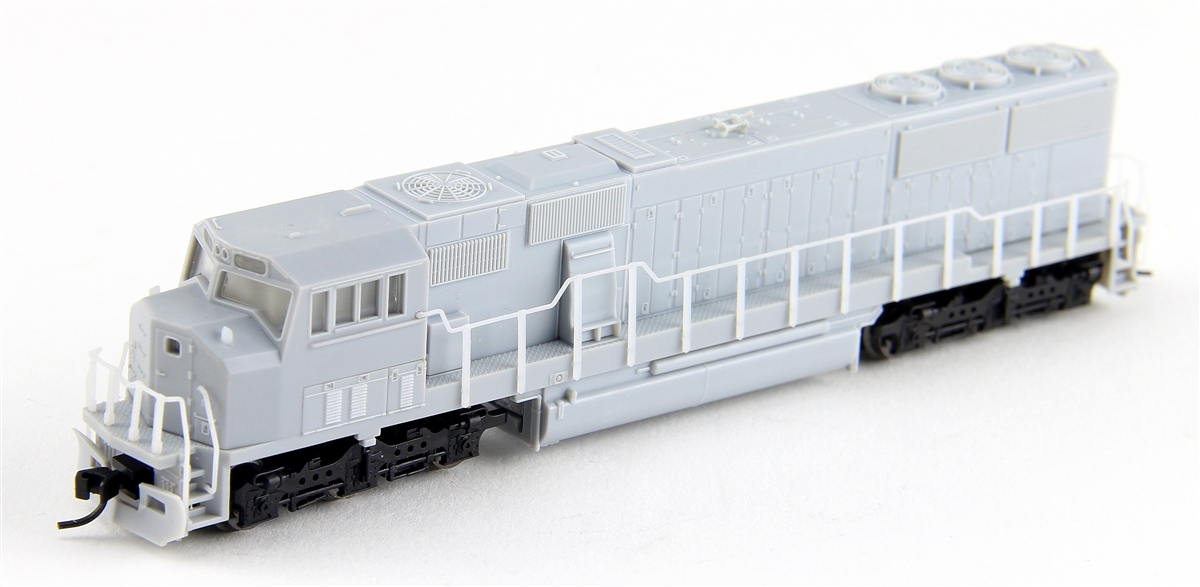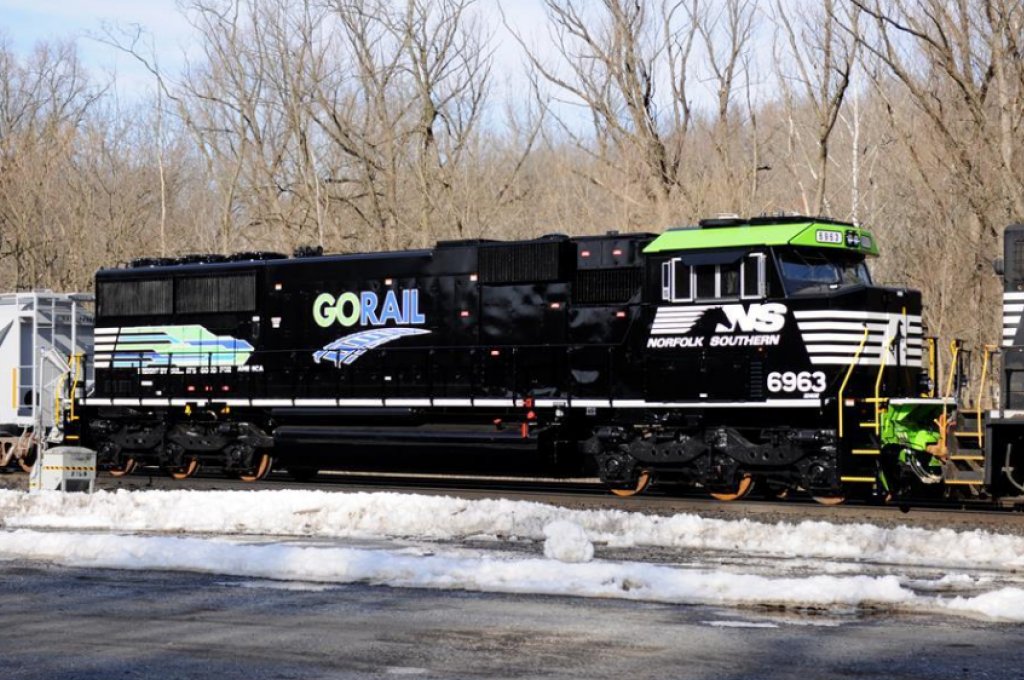Model Information: Atlas introduced the SD60 in 1998. The SD50 and SD60M followed in 1999. In 2002 they revised the SD60M and SD50. In 2005, Atlas revised the SD60. All three models (SD60, SD60M and SD50) share the same mechanism and differ only in shell detailing. These models also come with uninstalled detail parts such as snow-plow and winterization hatches. These details must be installed by the owner.
The revised versions all carry typical post-2000 mechanisms. Therefore, we see features such as dial flywheels, all-wheel pickup and drive, blackened metal wheels, bi-directional lighting, a split-frame DCC-Ready chassis and easily-swappable body-mount couplers. The revised version feature Atlas' slow-speed motor, golden white LEDs and nicely painted two-tone handrails. Yes, they run very nicely.
The revised versions all carry typical post-2000 mechanisms. Therefore, we see features such as dial flywheels, all-wheel pickup and drive, blackened metal wheels, bi-directional lighting, a split-frame DCC-Ready chassis and easily-swappable body-mount couplers. The revised version feature Atlas' slow-speed motor, golden white LEDs and nicely painted two-tone handrails. Yes, they run very nicely.
DCC Information: The revised version of this model is DCC ready. It is available either in DC or DCC-equipped, with Lenz LE062XF for earlier runs, and with NCE N12A1 for more recent ones.
Models accept the following after market plug-in decoders:
- Digitrax DN163A1: 1 Amp N Scale Mobile Decoder for Atlas N-Scale SD60, SD60M, SD50 and others.
- TCS ALD4: Four Function decoder, for Atlas Long length Drop-in.
- NCE N12A1: Plug and play decoder for N-Scale Atlas SD50, SD60M, SD60.
Models accept the following after market plug-in decoders:
- Digitrax DN163A1: 1 Amp N Scale Mobile Decoder for Atlas N-Scale SD60, SD60M, SD50 and others.
- TCS ALD4: Four Function decoder, for Atlas Long length Drop-in.
- NCE N12A1: Plug and play decoder for N-Scale Atlas SD50, SD60M, SD60.
Prototype History: In the late 2000’s, Norfolk Southern looked for ways to increase the life of their SD60 fleet. One factor NS had for them was their venerable Juniata Locomotive Shop in Altoona, Pa, which has the ability and a proven history of rebuilding just about any type of locomotive. Enter the “SD60E”, which would take SD60 cores (The first 240 planned would be from standard cab SD60’s, which was a mixture of NS and former lease locomotives) and add a new cab designed by NS, which was called a “Crescent Cab”. The locomotive received upgrades to the motor, fuel tank (On earlier rebuilds), and microprocessor controls to name a few. The first SD60E rolled out in 2010 as number 6900, which was rebuilt from NS 6653. Soon, more would follow and the current totals are at 136 rebuilt so far (NS 6900-7035). More rebuilds are planned into 2019 and eventually their SD60M and SD60I fleet will be rebuilt. What makes the SD60E even more unique from their browed cabs, is that three locomotives wear commemorative schemes honoring, Veterans, First Responders, and the “GORAIL” project. Atlas’ representation captures every detail, right down to the PTC Antenna Array on top of the cab roof.
From Atlas Model Railroad Co.
Read more on Wikipedia
From Atlas Model Railroad Co.
Read more on Wikipedia
Road Name History:  Although they may be molded in color, unpainted and unlettered, undecorated products are marketed to modelers who seek to custom decorate their models for private roads and/or road and/or company names that were not commercially produced by any of the major manufacturers.
Although they may be molded in color, unpainted and unlettered, undecorated products are marketed to modelers who seek to custom decorate their models for private roads and/or road and/or company names that were not commercially produced by any of the major manufacturers.
Undecorated models are frequently also unassembled or only partially assembled and required modelers to be comfortable with glue, paint and sometimes solder in order to prepare their models for display. Materials for these models can vary but often include plastic, pewter and resin. Models may or may not come with decals or other decorations such as plastic signage, railings and ladders to enhance the appearance of the final product.

Undecorated models are frequently also unassembled or only partially assembled and required modelers to be comfortable with glue, paint and sometimes solder in order to prepare their models for display. Materials for these models can vary but often include plastic, pewter and resin. Models may or may not come with decals or other decorations such as plastic signage, railings and ladders to enhance the appearance of the final product.
Brand/Importer Information: In 1924 Stephan Schaffan, Sr. founded the Atlas Tool Company in Newark, New Jersey. In 1933 his son, Stephan Schaffan, Jr., came to work for his father at the age of sixteen. Steve Jr. built model airplanes as a hobby and frequented a local hobby shop. Being an enterprising young man, he would often ask the owner if there was anything he could do to earn some extra spending money. Tired of listening to his requests, the hobby-store owner threw some model railroad track parts his way and said, "Here, see if you can improve on this".
In those days, railroad modelers had to assemble and build everything from scratch. Steve Jr. created a "switch kit" which sold so well, that the entire family worked on them in the basement at night, while doing business as usual in the machine shop during the day.
Subsequently, Steve Jr. engineered the stapling of rail to fiber track, along with inventing the first practical rail joiner and pre-assembled turnouts and flexible track. All of these products, and more, helped to popularize model railroading and assisted in the creation of a mass-market hobby. The budding entrepreneur quickly outgrew the limitations of a basement and small garage operation. Realizing they could actually make a living selling track and related products, Steve and his father had the first factory built in Hillside, New Jersey at 413 Florence Avenue in 1947. On September 30, 1949, the Atlas Tool Company was officially incorporated as a New Jersey company.
In 1985, Steve was honored posthumously for his inventions by the Model Railroad Industry Association and was inducted into the Model Railroad Industry Hall of Fame in Baltimore, Maryland. In addition, Steve was nominated and entered into the National Model Railroad Association Pioneers of Model Railroading in 1995.
In the early 1990s, the Atlas Tool Company changed its name to Atlas Model Railroad Company, Inc.
In those days, railroad modelers had to assemble and build everything from scratch. Steve Jr. created a "switch kit" which sold so well, that the entire family worked on them in the basement at night, while doing business as usual in the machine shop during the day.
Subsequently, Steve Jr. engineered the stapling of rail to fiber track, along with inventing the first practical rail joiner and pre-assembled turnouts and flexible track. All of these products, and more, helped to popularize model railroading and assisted in the creation of a mass-market hobby. The budding entrepreneur quickly outgrew the limitations of a basement and small garage operation. Realizing they could actually make a living selling track and related products, Steve and his father had the first factory built in Hillside, New Jersey at 413 Florence Avenue in 1947. On September 30, 1949, the Atlas Tool Company was officially incorporated as a New Jersey company.
In 1985, Steve was honored posthumously for his inventions by the Model Railroad Industry Association and was inducted into the Model Railroad Industry Hall of Fame in Baltimore, Maryland. In addition, Steve was nominated and entered into the National Model Railroad Association Pioneers of Model Railroading in 1995.
In the early 1990s, the Atlas Tool Company changed its name to Atlas Model Railroad Company, Inc.
Item created by: Powderman on 2018-09-02 16:28:51. Last edited by CNW400 on 2020-07-30 10:06:17
If you see errors or missing data in this entry, please feel free to log in and edit it. Anyone with a Gmail account can log in instantly.
If you see errors or missing data in this entry, please feel free to log in and edit it. Anyone with a Gmail account can log in instantly.










